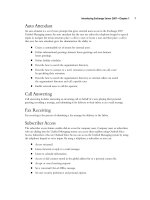Exxhange SQL And IIS- P12 potx
Bạn đang xem bản rút gọn của tài liệu. Xem và tải ngay bản đầy đủ của tài liệu tại đây (69.53 KB, 5 trang )
22 Chapter 1 • Introducing Exchange Server 2007
Recipient-related Features
■
Exchange extensions in Active Directory Users and Computers MMC snap-in
■
Microsoft Exchange Server Mailbox Merge Wizard (ExMerge)
■
Recipient Update Service (RUS)
Mobile Features
■
Outlook Mobile Access (OMA)
■
Outlook Mobile Access Browse
■
Always-Up-To-Date version 1 (AUTD v1)
■
S/MIME (will be back when Exchange 2007 SP1 releases)
Outlook Web Access Features
■
S/MIME Control component (will be back when Exchange 2007 SP1 releases)
■
Rules, Notes, Post Forms, Monthly Calendar view
■
Custom Forms
■
Editing personal distribution lists
■
URL commands except for free/busy, galfi nd, navbar and contents
■
Public folder access
■
Exchange Web forms
Public Folder Features
■
Public Folder Management via GUI (but will be back when Exchange 2007 SP1 releases)
■
Non-MAPI top-level hierarchies in a public folder store
■
Public folder access using NNTP
■
Public folder access using IMAP4
Protocol Features
■
Network News Transfer Protocol (NNTP)
■
Management of POP3/IMAP4 via GUI (Will most likely be back when Exchange 2007
SP1 releases)
■
X.400 Message Transfer Agent (MTA)
■
SMTP Virtual Server Instances
Introducing Exchange Server 2007 • Chapter 1 23
Connector Features
■
Connector for Novell GroupWise and migration tools
■
Connector for Lotus Notes (an Exchange 2007 version is under development)
HA Features
■
Active/Active (A/A) clustering
Exchange 5.5-related Features
■
Installing Exchange 5.5. into an Exchange 2007 organization
■
Support for Exchange 5.5 in same forest as Exchange 2007
■
Installing Exchange 2007 into an organization containing Exchange 5.5 servers
(mixed mode)
■
Active Directory Connector (ADC)
■
Site Replication Service (SRS)
APIs and Development Features
■
Transport Event hooks
■
Workfl ow Designer (included in Exchange 2003 SDK)
■
CDO for Workfl ow (on Exchange 2003 media)
■
CDOEXM
■
Exchange WMI classes
■
MAPI Client on Exchange Server
Tools and Management Features
■
Monitoring and Status Node
■
Message Tracking Center Node and tracking mechanism
■
Mailbox Recovery Center
■
Mailbox Management Service
■
Clean Mailbox tool
■
Migration Wizard
■
ExProfRe
■
Inter-Organization Replication tool (InterORG)
24 Chapter 1 • Introducing Exchange Server 2007
Summary
Exchange Server 2007 is a huge product packed with many completely new features, as well as
improvements to existing features from Exchange 2003. This chapter took a brief look at some of the
more interesting new features such as the EMC and the EMS, as well as the new HA improvements.
This chapter discussed the fact that Exchange 2007 is the fi rst 64-bit version of Exchange ever
released, and listed all the features that have been de-emphasized or even discontinued in Exchange
Server 2007.
25
Installing Exchange
Server 2007
Chapter 2
Solutions in this chapter:
■
Exchange 2007 Server Editions and CAL Types
■
Exchange 2007 Prerequisites
■
Installing Exchange 2007 Using the Setup Wizard
■
Installing Exchange 2007 Using Unattended
Setup
■
Verifying the Installation of Exchange
Server 2007
■
Licensing an Exchange 2007 Server
■
Finalizing Deployment of Exchange Server 2007
■
Adding and Removing Exchange 2007
Server Roles
■
Uninstalling Exchange Server 2007
˛
Summary
˛ Solutions Fast Track
˛ Frequently Asked Questions
26 Chapter 2 • Installing Exchange Server 2007
Introduction
In this chapter, we will go through the requirements of Exchange 2007. We’ll look at what’s required
in terms of hardware and software, in addition to the Active Directory forest in which Exchange
Server 2007 is to be installed. We’ll then see, step by step, how you install Exchange 2007 Server into
a clean Active Directory forest (that is, a forest that doesn’t contain an Exchange organization or has
had the schema extended with the Exchange attributes). We’ll also take a brief look at the new
Finalizing Deployment and End-to-End Scenario pages. Finally, you’ll get an understanding of how
you add and remove Exchange 2007 server roles on an existing Exchange 2007 server as well as how
to remove an Exchange 2007 server from your organization.
This chapter does not cover transitions, coexistence, and other interoperability with Exchange
2000, 2003, and foreign messaging systems; it simply goes through the procedures of installing
Exchange Server 2007 in a clean Active Directory environment. It also does not cover complex
Exchange organizations distributed across multiple physical locations involving multiple Active
Directory forests. The intention of the chapter is to get you started with the product.
Coexistence and Exchange 2007 transitions are covered in Chapter 10.
Exchange 2007 Server Editions
and CAL Types
As is the case with previous versions of Exchange, Exchange Server 2007 exists in two different
editions: a Standard Edition and an Enterprise Edition.
Standard Edition
Like previous Standard Editions of Exchange, Exchange 2007 Standard Edition has been designed to
meet the messaging and collaboration requirements of small to medium-sized corporations and is
aimed at meeting specifi c messaging server roles, such as branch offi ces. The Standard Edition has:
■
Support for fi ve storage groups
■
Support for fi ve databases
■
No database storage limit
■
Local Continuous Replication (LCR)
NOTE
Now that we are accustomed to referring to the EDB databases as Mailbox and
Public Folder “Stores”, the Exchange Product group thought they should be changed
back to Mailbox and Public Folder “Databases”, as they were prior to and including
Exchange 5.5.









